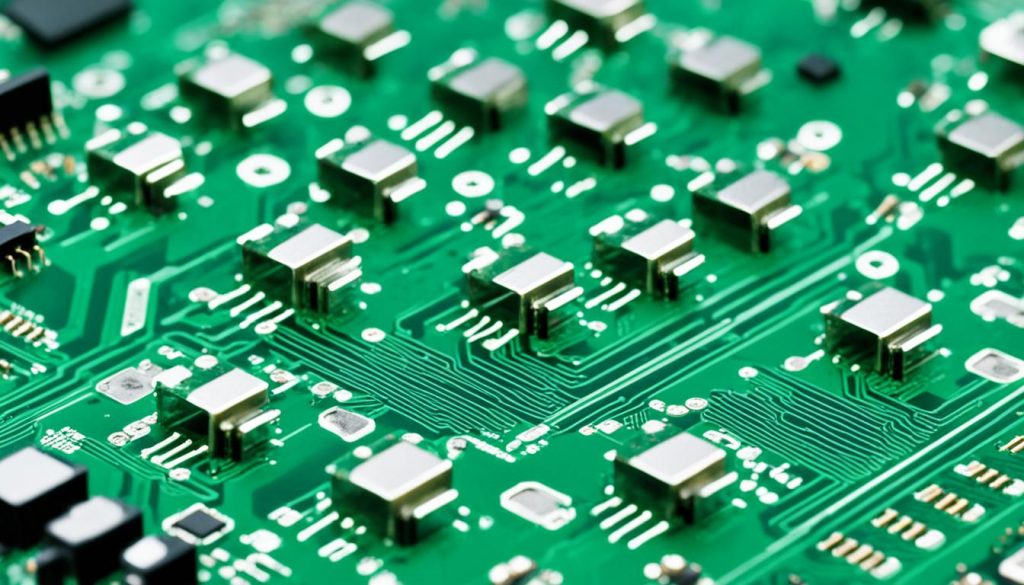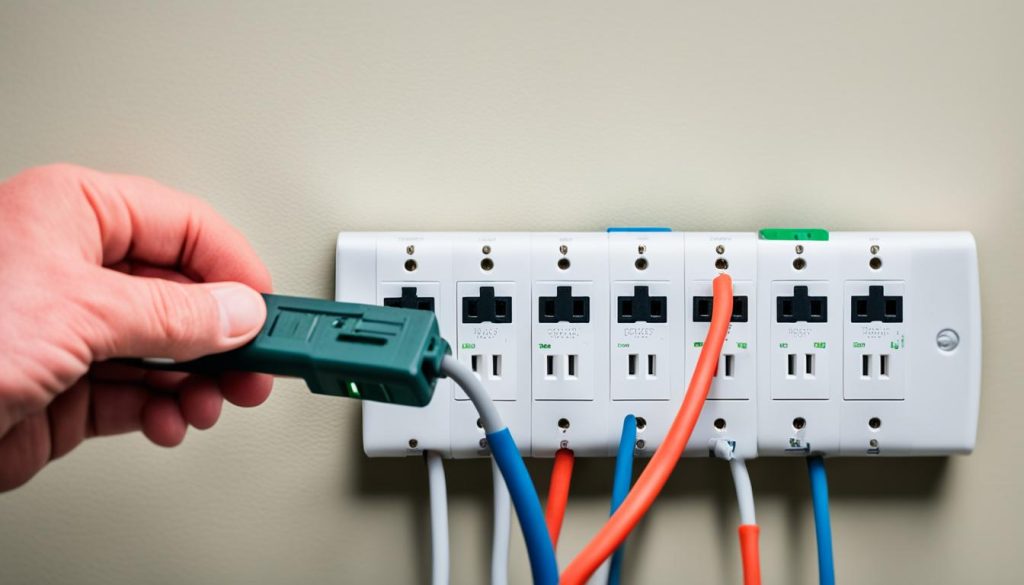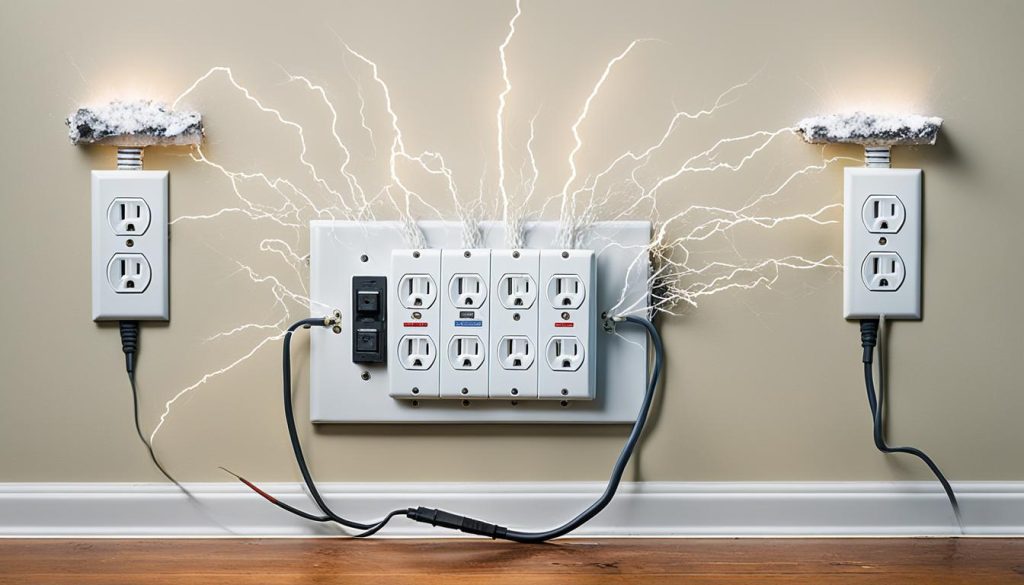Surge protectors play a crucial role in safeguarding your electronic devices from power surges and spikes. While lightning is often a concern, most power surges are caused by power utility spikes and the cycling on and off of large electronics. These smaller, repeated power surges can gradually damage your devices over time. That’s why surge protection is essential, and the joule rating of a surge protector determines its ability to absorb energy and offer adequate protection. The higher the joule rating, the better the protection the surge protector provides.
Key Takeaways:
- Surge protectors are crucial for protecting electronic devices from power surges and spikes.
- Power utility spikes and cycling of large electronics are the main causes of power surges.
- Smaller, repeated power surges can damage devices over time.
- The joule rating of a surge protector determines its ability to absorb energy and provide protection.
- The higher the joule rating, the better the protection.
What is a Joule?
A joule is a unit of measurement for energy released over time. It is used to quantify the amount of energy a surge protector can absorb before it fails. The energy absorbed is expressed in watts, with a watt being the amount of energy (in joules) an electrical device burns per second.
For example, a surge protector with a joule rating of 3,000 can absorb energy surges totaling up to 3,000 joules. It’s important to note that each surge depletes the joules, so with enough surges, the surge protector will no longer offer effective protection.
Understanding Joules
To put it simply, a joule represents the capacity of a surge protector to handle power surges. The joule rating is a measure of the surge protector’s resilience and ability to absorb excess voltage. A higher joule rating indicates a surge protector’s superior capability in handling larger and more frequent surges effectively.
Joules are like a reserve tank for your surge protector. The more joules it has, the more protection it can offer to your devices against power surges.
How a Joule Works in a Surge Protector
The number of joules in a surge protector is determined by the number and size of Metal Oxide Varistors (MOVs) it contains. MOVs are responsible for absorbing excess voltage during a surge event and diverting it away from connected devices. Multiple MOVs work together to give a surge protector its joule rating. For example, an 1800-joule surge protector might have three 600-joule MOVs. It’s worth mentioning that surge protection can also be found in Uninterruptible Power Supply (UPS) systems, with outlets labeled as either “surge protection” or “battery backup.”

| Type of Surge Protector | Joule Rating | Number of MOVs |
|---|---|---|
| Basic Surge Protector | 500 joules | One 500-joule MOV |
| Standard Surge Protector | 1000 joules | Two 500-joule MOVs |
| Advanced Surge Protector | 1800 joules | Three 600-joule MOVs |
How Many Joules Do I Need?
The joule rating you need for your surge protector depends on the value and type of equipment you want to protect. As a general guideline, the higher the value of your equipment, the higher the joule rating should be. Here’s a chart with recommended joule ratings for various devices:
| Device | Recommended Joule Rating |
|---|---|
| Laptop/Computer | 1,000 – 2,000 joules |
| Television | 2,000 – 4,000 joules |
| Home Theater System | 3,000 – 6,000 joules |
| Gaming Console | 2,000 – 4,000 joules |
| Major Appliances | 4,000 – 6,000 joules |
| Smartphone/Tablet | 500 – 1,000 joules |
| Printers/Scanners | 1,000 – 2,000 joules |
Keep in mind that these recommendations serve as a starting point and may vary depending on product specifications and personal preference. It’s always better to err on the side of caution and choose a surge protector with a higher joule rating to ensure optimal protection for your valuable devices.
Monitoring and Replacing Surge Protectors
Surge protectors are essential for safeguarding your electronic devices from power surges. However, they don’t last forever and will eventually wear out over time. Even higher-rated surge protectors will wear out, so it’s important to monitor their functionality and consider replacing them when necessary.
Most surge protectors have an LED light that indicates if protection is still present. This light serves as a helpful indicator, letting you know if your devices are still being protected. If the LED light is not functioning or if you’ve experienced a major electrical event, it’s a good idea to check the status of your surge protector and consider replacing it.
Additionally, surge protectors that are hidden or placed behind furniture should be regularly checked to ensure their functionality. Dust, debris, and physical damage can affect their performance, so it’s important to keep them clean and easily accessible.
When it comes to replacing surge protectors, consider the surge protector joule rating. As discussed in Section 1, the joule rating determines the level of protection the surge protector offers. A surge protector with a higher joule rating provides better protection for your devices.
Regularly monitoring and replacing surge protectors will ensure the continued safety of your valuable electronic devices. Don’t wait for a power surge to damage your equipment – be proactive and take the necessary steps to protect your investment.

Remember:
- Check the LED light on your surge protector to ensure protection is still present.
- Inspect surge protectors that are hidden or placed behind furniture for any damage or debris.
- Consider replacing surge protectors after a major electrical event or several years of use.
- Choose a surge protector with a higher joule rating for increased protection.
Location and Types of Power Surges
Power surges can originate from different sources, both natural and man-made. While lightning strikes can cause surges, they are not the only source. High-power electrical devices, such as refrigerators or air conditioners, can create power surges when they cycle on and off. Additionally, poor electrical wiring can exacerbate the problem. It’s important to note that up to 80% of all surges originate within the home or office, caused by the cycling on and off of various appliances. A whole-house surge protection system may not prevent these types of voltage spikes.
To effectively protect your devices from power surges, it is crucial to understand the importance of surge protector joule rating. The joule rating determines a surge protector’s ability to absorb energy and offer adequate protection. The higher the joule rating, the better the protection the surge protector provides against power surges.
Now that you know more about surge protector joule ratings, let’s move on to understanding how joules work in a surge protector.

Choosing the Right Surge Protector
When it comes to protecting your valuable equipment and devices holding sensitive data, choosing the right surge protector is crucial. One of the most important factors to consider is the surge protector joule rating, which indicates its ability to absorb energy and provide adequate protection.
In addition to the joule rating, it’s also essential to consider other factors such as the outlet count and cord length. Depending on your needs, you may require a surge protector with multiple outlets to accommodate all your devices, or one with a longer cord to reach distant power sources.
Remember that surge protectors don’t last forever. Regularly monitoring the surge protector’s LED light can help ensure that protection is still present. Additionally, it’s advisable to replace surge protectors after major electrical events or several years of use to maintain optimal performance and protect your devices.
Keep in mind that not all surge protectors are created equal. It’s crucial to choose one that meets your specific needs and offers adequate joule protection. By carefully considering the surge protector joule rating, outlet count, and cord length, you can make an informed decision and provide reliable protection for your valuable electronic devices.
FAQ
What is the importance of surge protector joule rating?
The joule rating of a surge protector determines its ability to absorb energy and offer adequate protection. The higher the joule rating, the better the protection the surge protector provides.
What is a joule and how does it relate to surge protectors?
A joule is a unit of measurement for energy released over time. It quantifies the amount of energy a surge protector can absorb before it fails. Surge protectors have a joule rating that indicates their capacity to absorb energy surges.
How do joules work in a surge protector?
Metal Oxide Varistors (MOVs) in a surge protector absorb excess voltage during a surge event and divert it away from connected devices. The number and size of MOVs determine the surge protector’s joule rating and its ability to protect devices from power surges.
How many joules do I need in a surge protector?
The joule rating you need for your surge protector depends on the value and type of equipment you want to protect. As a general guideline, the higher the value of your equipment, the higher the joule rating should be. Refer to the recommended joule rating chart for various devices.
How often should I monitor and replace surge protectors?
Surge protectors don’t last forever and will eventually wear out over time. It’s a good idea to regularly check the LED light on surge protectors to ensure protection is still present. If you’ve experienced a major electrical event or have been using surge protectors for several years, consider checking their status or replacing them.
What are the different types and sources of power surges?
Power surges can originate from various sources, including lightning strikes, high-power electrical devices cycling on and off, and poor electrical wiring. Up to 80% of all surges originate within the home or office due to appliances cycling on and off.
How do I choose the right surge protector?
When selecting a surge protector, consider the joule rating along with factors such as outlet count and cord length. For valuable equipment and devices holding sensitive data, investing in a surge protector with a high joule rating is crucial. Choose a surge protector that meets your specific needs and provides adequate joule protection.


